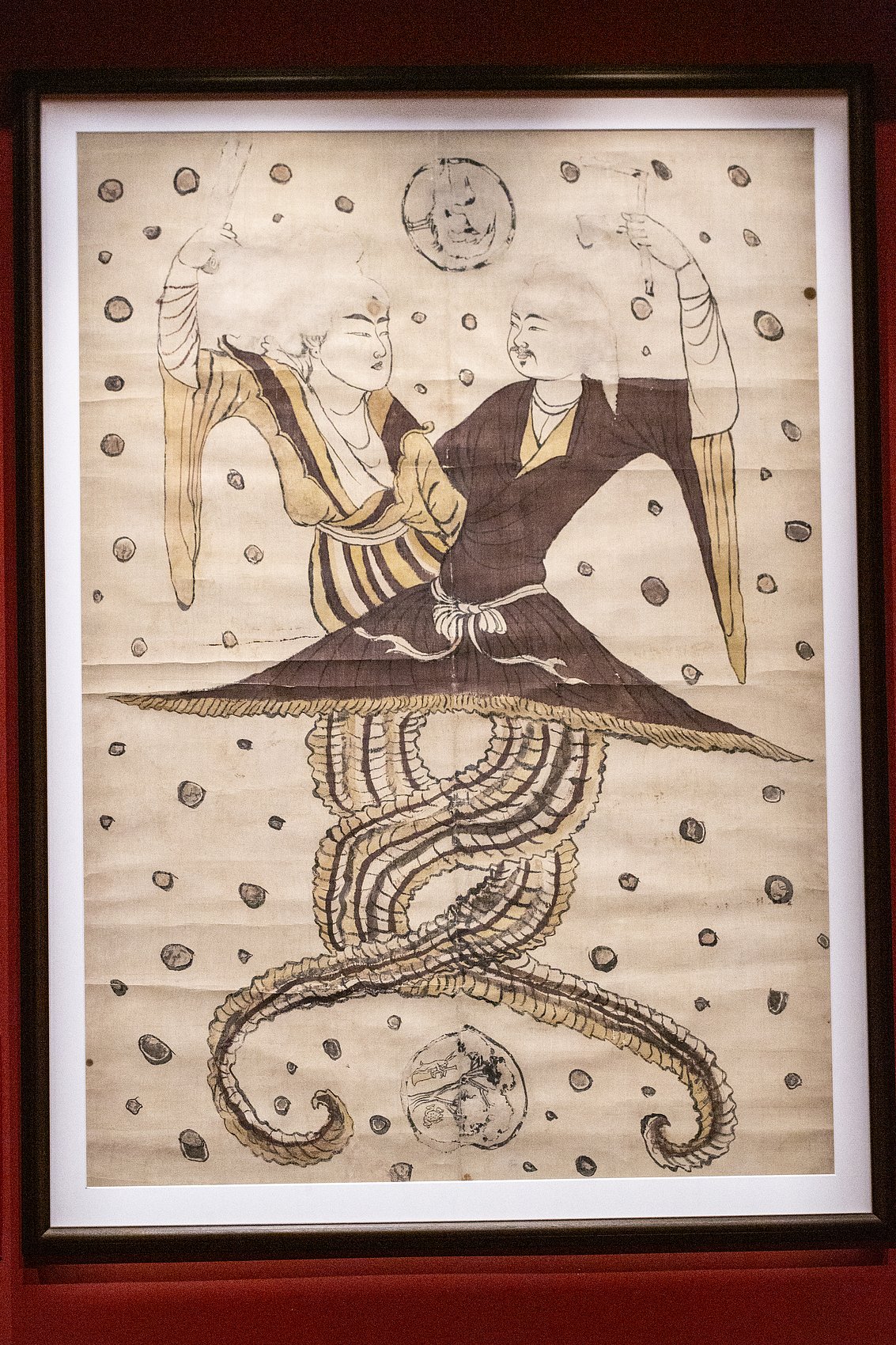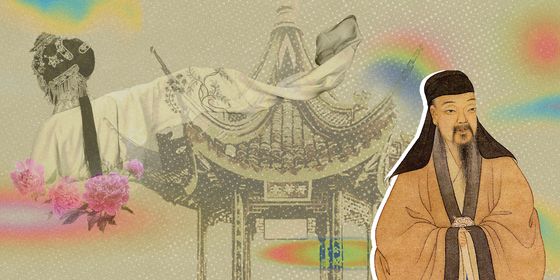How the snake evolved from a revered symbol of worship to a figure of fear and evil in ancient Chinese culture
Calling someone a snake might not win you any smiles today, but in ancient Chinese culture, snakes were revered as creator deities and symbols of mysterious forces. They starred in poignant love tales like “The Legend of the White Snake,” yet were also feared as harbingers of danger and evil. Among the 12 zodiac animals, the snake stands out for its particularly complex and contradictory symbolism. With the Year of the Snake just around the corner, it’s the perfect moment to uncover how this enigmatic creature has inspired worship, fear, and awe.
Like many origin myths around the world, ancient Chinese mythology also links snakes to themes of creation and procreation. One widely circulated story was recorded in the Chu Silk Manuscript, the earliest silk manuscript excavated in China, which dates back to the first century BCE. It recounts that in the chaos before the formation of heaven and earth, there were two deities, Fuxi and Nüwa. They became husband and wife, giving birth to four sons who became the deities representing the four seasons. Many ancient texts and works of art portray Fuxi and Nüwa as having human heads and snake bodies. In images etched into Han dynasty (206 BCE – 220 CE) stone and brick, Fuxi and Nüwa are depicted with snake tails (sometimes as dragon tails). Huangfu Mi (皇甫谧), a scholar from the third century, describes Fuxi in his work The Chronicles of Emperors(《帝王世纪》)as having “a human head and a snake body.” Meanwhile, around the same time, scholar Guo Pu (郭璞) described Nüwa in his annotation to The Classic of Mountains and Seas (《山海经》), a mythological text believed to have been compiled in the fourth or third centuries BCE, writing: “Nüwa, an ancient goddess and empress, had a human face and snake body, and she could transform seventy times in a single day.”
Read more about zodiac animal culture in China:
- The Many Faces of the Rabbit in Chinese History and Culture
- What Do Tigers Symbolize in China?
- The Ox in Myth and History
Many scholars believe that the Chinese veneration of the dragon, or “loong (龙),” evolved from the worship of snakes. The renowned modern scholar Wen Yiduo (闻一多) proposed that the primary prototype of the dragon is the snake in his groundbreaking study on ancient Chinese mythology, Research on Fuxi (《伏羲考》), in 1942. He wrote: “Before the totemic integration, the so-called dragon was merely a large snake, which was named ‘loong.’ Later, a powerful tribe that worshipped this large snake as their totem merged with and absorbed other tribes with various totems. As a result, the large snake acquired features from other animals, such as the four legs of a beast, the head of a horse, the mane of a hyena, the antlers of a deer, the claws of a dog, and the scales and whiskers of a fish...Then, it formed the Chinese dragon as we know it today.” To this day, people still commonly use the term “little dragon” to refer to a snake, reflecting the deep-rooted connection between the two in Chinese culture.
The worship of snakes themselves still persists today. In many rural areas of Fujian province, “Snake King Palaces” and “Snake King Temples” are very common, where snakes are revered and offered sacrifices. In Nanping, during the Lantern Festival, people dance and parade with “bamboo snake lanterns” to seek blessings from the snake deity. The lantern’s “snake body” is made of wooden boards connected end-to-end, with lanterns placed on each board. The “snakehead” and “snake tail” are crafted from bamboo frames, covered with colorful paper, and decorated with scales to resemble a giant serpent. The locals also celebrate the “Snake King Festival,” which falls on the seventh day of the seventh lunar month each year, known as the Qixi Festival in other parts of China. People of all ages—men, women, the young, and the elderly—hold live snakes in their hands as drums and music play, dancing to pray for peace.
During the Han dynasty, the image of the snake became more associated with imperial power. According to the Records of the Grand Historian (《史记》), a chronicle written by Han-dynasty historian Sima Qian (司马迁), when Liu Bang (刘邦), the founder of the Han dynasty, was serving as a village head, he passed through a marsh, where he encountered a large white snake blocking his way. Liu drew his sword and cut the snake in half. Subsequently, passersby saw an old woman weeping over the snake. She claimed that the snake was the son of the White Emperor, and it had just been killed by the son of the Red Emperor, who had passed by. After speaking, the old woman vanished. Such a legend undoubtedly added a mystical aura to Liu Bang’s rise to power, while also indicating that snakes were used as a symbol for emperors. It wasn’t until later dynasties that the dragon became the exclusive symbol of imperial power.
In many stories, snakes are also believed to possess mysterious powers and abilities. In the Record of Heretofore Lost Works (《拾遗记》), a collection of ancient legends compiled by Wang Jia (王嘉) during the Eastern Jin dynasty (317 – 420), it is recorded that a woman traveling down the river had a long white snake leap into her boat. The woman said, “If you are auspicious, do not harm me,” and placed the snake in a box. When she checked it the next day, the snake was gone. However, a neighbor claimed to have seen a white crane flying away from her house. After consulting a diviner, she was told that her descendants would be noble, thanks to the blessings of the snake and crane. Indeed, her grandson later went on to become prime minister.
But gradually, in folk tales, the image of the snake began to take on an evil connotation. During the Tang dynasty (618 – 907), a story from Records of Strange Events (《博异志》) featured a murderous snake spirit. In the story, a young man named Li Huang, the son of a salt and iron commissioner from Longxi, encountered a beautiful, widowed woman dressed in white while he was wandering in the eastern market of Chang’an. Li was invited to her home after lending her money to buy silk. The woman’s aunt, an elderly woman in blue, proposed that if Li could repay their debt of 30,000 coins, the woman would marry him. Li agreed and stayed with the woman for three days before returning home. However, upon his return, Li’s body emitted a foul, fishy odor, and he began to feel his limbs grow heavy and his head become dizzy. Eventually, he lay down, wrapped in a quilt. When his family found him, his body had turned into water, leaving only his head. Upon visiting the woman’s residence, they found an empty house with a soapberry tree in the courtyard. The tree had 15,000 coins hanging from its branches and another 15,000 coins placed beneath it. Locals reported that a large white snake often appeared under the tree.
And then there is “The Legend of the White Snake,” one of the four great Chinese folk love legends, in which the snake has again become an image of kindness and affection. In this story, a thousand-year-old white snake spirit transforms into a beautiful woman to repay the kindness of a young scholar, who saved her during a previous life. The two marry and then undergo numerous trials and tribulations due to their forbidden love.
But more often than not, “snake” would be used as a pejorative against political rivals. During the Tang dynasty, Empress Wu Zetian (武则天), the only female emperor in Chinese history, used derogatory characters, many referring to snakes, to humiliate her rivals. According to the Old Book of Tang (《旧唐书》), she changed the surname of her husband Emperor Gaozong’s first wife, Empress Wang, to “Mang (蟒, python).” She also changed the surname of her cousins Wu Weiliang (武惟良) and Wu Huaiyun (武怀运), whom she saw as political obstacles, to “Fu (蝮, viper).” Additionally, she changed the surname of Li Zhen (李贞), the Prince of Yue who rebelled against her, to “Hui (虺, adder).”
To this day, idioms and colloquial expressions related to snakes still mostly carry negative connotations. For example, saying someone has the “heart of a snake and scorpion (蛇蝎心肠)” means that this person is evil and vicious; “snake trying to swallow an elephant (蛇吞象)” is a description of greed; “a nest of snakes and rats (蛇鼠一窝)” means that evil people collude with one another, and “ox ghosts and snake gods (牛鬼蛇神)” is a metaphor for all kinds of bad people.
New Year’s is, of course, a time for joy and fortune. So here’s an interesting challenge: How will people incorporate more auspicious phrases related to snakes into their New Year’s greetings?
















